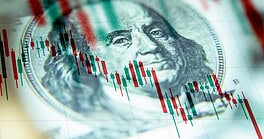Currency Distribution Of Global Foreign Exchange Market Turnover
Currency distribution of foreign exchange market turnover reflects the share of overall trading volumes of a particular currency.
The US dollar continues to decline in terms of percentage share of daily foreign exchange market turnover, however it is still the most-traded currency by quite some ways—accounting for an 84.9% share of average daily turnover in 2010.
It is followed by the Euro—which grew to a 39.1% share of average daily turnover. The Japanese yen regained some market share—after declining in the 2007 survey—to hold a 19.0% share of daily turnover.
Total turnover shares equal 200%—rather than 100%–as there are two currencies in each trade and each currency is credited with its share of a particular trade.
The Australian and Canadian dollars each saw a big increase in market share between 2007 and 2010, as did the market share of emerging market currencies.
Data is from the Bank for International Settlements Triennial Central Bank Survey of Foreign Exchange and Derivatives Market Activity, September, 2010.
Click on the column heading to sort the table.
Currency Distribution Of Global Foreign Exchange Market Turnover



